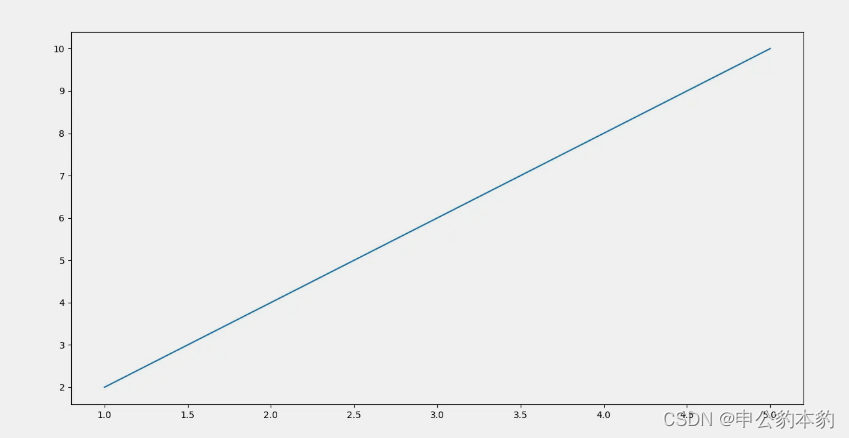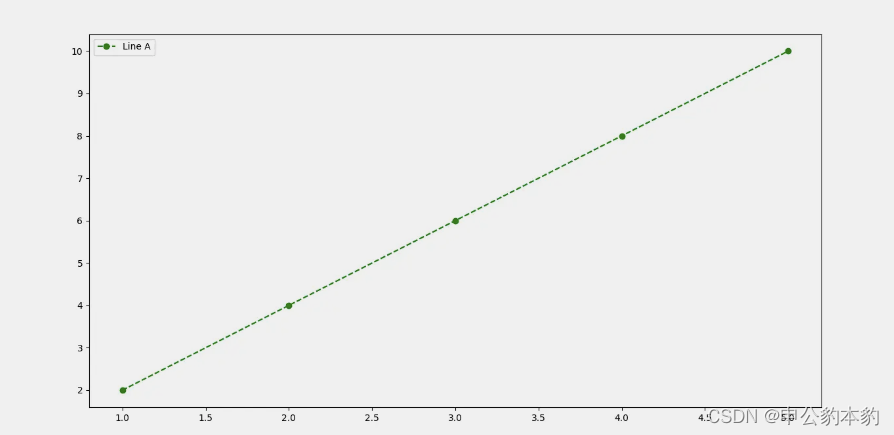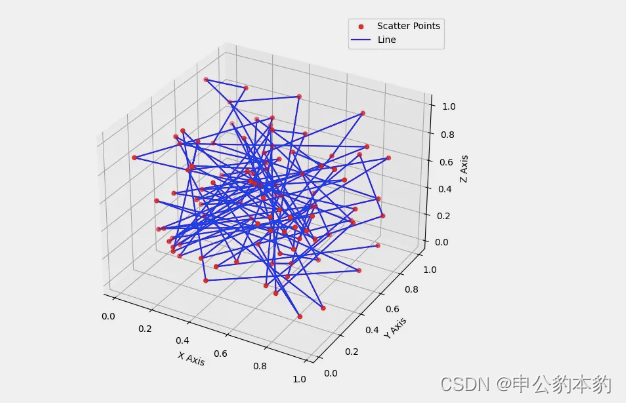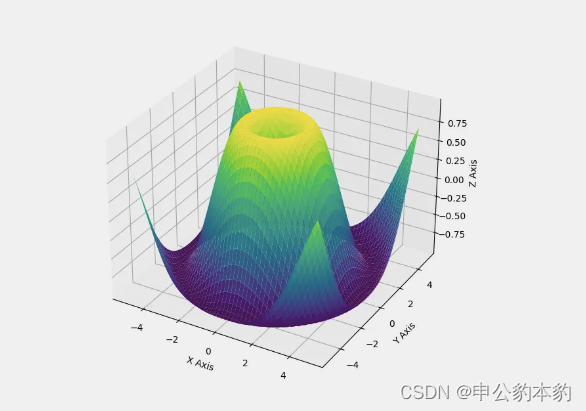Matplotlib: 强大的数据可视化工具
Matplotlib 是一个功能强大的数据可视化库,为数据科学家提供了丰富的工具和功能,可以以直观的方式呈现数据。
1. 基础
1.1 安装 Matplotlib
在使用 Matplotlib 之前,请确保已经安装了 Matplotlib 库。可以使用以下命令进行安装:
1.2 创建第一个简单的图表
安装好 Matplotlib 后,让我们来创建一个简单的折线图。以下是一个基本的示例:
import matplotlib.pyplot as plt
# 数据x = [1, 2, 3, 4, 5]y = [2, 4, 6, 8, 10]
# 创建折线图plt.plot(x, y)
# 显示图表plt.show()
复制代码
通过运行这段代码,我们可以得到一个简单的折线图,其中横轴为 x,纵轴为 y。
1.3 图表的基本组件:标题、轴标签、图例
在 Matplotlib 中,我们可以添加图表的基本组件,以提高图表的可读性。以下是一些基本组件的添加示例:
# 添加标题plt.title('My First Matplotlib Plot')
# 添加轴标签plt.xlabel('X-axis Label')plt.ylabel('Y-axis Label')
# 添加图例plt.legend(['Line A'])
# 显示图表plt.show()
复制代码
通过添加标题、轴标签和图例,我们可以使图表更加清晰明了。
2. 常见图表类型
在数据可视化中,Matplotlib 提供了多种图表类型,以满足不同数据展示需求。以下是几种常见的图表类型及其应用:
2.1 折线图
折线图适用于展示数据随时间变化的趋势或比较不同组的趋势。以下是一个折线图的示例:
# 数据x = [1, 2, 3, 4, 5]y = [2, 4, 6, 8, 10]
# 创建折线图plt.plot(x, y)
# 显示图表plt.show()
复制代码
2.2 散点图
散点图适用于观察两个变量之间的关系或发现数据中的聚类或趋势。以下是一个散点图的示例:
# 数据x = [1, 2, 3, 4, 5]y = [2, 4, 6, 8, 10]
# 创建散点图plt.scatter(x, y)
# 显示图表plt.show()
复制代码
2.3 条形图
条形图适用于比较不同类别的数据或显示类别之间的数量差异。以下是一个条形图的示例:
# 数据categories = ['A', 'B', 'C', 'D']values = [10, 15, 7, 12]
# 创建条形图plt.bar(categories, values)
# 显示图表plt.show()
复制代码
2.4 直方图
直方图适用于展示数据的分布或显示数据的频率。以下是一个直方图的示例:
# 数据data = [2, 3, 3, 4, 4, 4, 5, 5, 6, 6, 6, 6, 7, 7, 8]
# 创建直方图plt.hist(data, bins=5)
# 显示图表plt.show()
复制代码
通过使用这些常见的图表类型,我们可以更好地理解和传达数据的特征、关系和分布。
3. 图表样式与定制
Matplotlib 允许通过定制颜色、线型、标记等来创建个性化的图表。以下是一些图表样式与定制的示例:
3.1 颜色、线型、标记的定制
# 数据x = [1, 2, 3, 4, 5]y = [2, 4, 6, 8, 10]
# 定制颜色、线型、标记plt.plot(x, y, color='green', linestyle='--', marker='o', label='Line A')
# 添加图例plt.legend()
# 显示图表plt.show()
复制代码
3.2 背景样式与颜色映射
# 数据x = np.linspace(0, 10, 100)y = np.sin(x)
# 定制背景样式与颜色映射plt.plot(x, y, color='blue')
# 设定背景颜色plt.axes().set_facecolor('lightgray')
# 显示图表plt.show()
复制代码
3.3 添加注释与文本
# 数据x = [1, 2, 3, 4, 5]y = [2, 4, 6, 8, 10]
# 添加注释与文本plt.plot(x, y, label='Line A')plt.annotate('Max Value', xy=(5, 10), xytext=(4.5, 8), arrowprops=dict(facecolor='red', shrink=0.05))plt.text(1, 2, 'Start Point', fontsize=10, color='blue')
# 添加图例plt.legend()
# 显示图表plt.show()
复制代码
通过这些定制,我们可以使图表更符合审美和需求。
4. 多图表和子图
在 Matplotlib 中,我们可以创建包含多个子图的图表,以更灵活地展示数据或进行比较。以下是创建多个图表和子图的示例:
4.1 创建多个图表
# 数据x = [1, 2, 3, 4, 5]y1 = [2, 4, 6, 8, 10]y2 = [1, 2, 1, 2, 1]
# 创建第一个图表plt.figure(1)plt.plot(x, y1, label='Line A')plt.title('First Chart')
# 创建第二个图表plt.figure(2)plt.plot(x, y2, label='Line B')plt.title('Second Chart')
# 显示图表plt.show()
复制代码
4.2 子图的布局与排列
# 数据x = [1, 2, 3, 4, 5]y1 = [2, 4, 6, 8, 10]y2 = [1, 2, 1, 2, 1]
# 创建一个包含两个子图的图表plt.figure(figsize=(10, 4))
# 子图1plt.subplot(1, 2, 1)plt.plot(x, y1, label='Line A')plt.title('Subplot 1')
# 子图2plt.subplot(1, 2, 2)plt.plot(x, y2, label='Line B')plt.title('Subplot 2')
# 调整子图之间的间距plt.tight_layout()
# 显示图表plt.show()
复制代码
通过 plt.subplot 方法,我们可以在一个图表中创建多个子图,并通过指定行数和列数来排列它们。
5. 三维图表
Matplotlib 还提供了创建各种三维图表的功能,包括 3D 散点图、3D 线图、3D 表面图等。以下是几个示例:
5.1 3D 散点图与线图
import matplotlib.pyplot as pltfrom mpl_toolkits.mplot3d import Axes3Dimport numpy as np
# 生成随机数据n = 100x = np.random.rand(n)y = np.random.rand(n)z = np.random.rand(n)
# 创建3D散点图fig = plt.figure()ax = fig.add_subplot(111, projection='3d')ax.scatter(x, y, z, c='r', marker='o', label='Scatter Points')
# 创建3D线图ax.plot(x, y, z, c='b', label='Line')
# 添加标签ax.set_xlabel('X Axis')ax.set_ylabel('Y Axis')ax.set_zlabel('Z Axis')
# 添加图例ax.legend()
# 显示图表plt.show()
复制代码
5.2 3D 表面图与曲面图
import matplotlib.pyplot as pltfrom mpl_toolkits.mplot3d import Axes3Dimport numpy as np
# 生成网格数据x = np.linspace(-5, 5, 100)y = np.linspace(-5, 5, 100)x, y = np.meshgrid(x, y)z = np.sin(np.sqrt(x**2 + y**2))
# 创建3D表面图fig = plt.figure()ax = fig.add_subplot(111, projection='3d')ax.plot_surface(x, y, z, cmap='viridis')
# 添加标签ax.set_xlabel('X Axis')ax.set_ylabel('Y Axis')ax.set_zlabel('Z Axis')
# 显示图表plt.show()
复制代码
通过使用mpl_toolkits.mplot3d中的Axes3D,我们可以在 Matplotlib 中创建三维图表。
6. 实际案例:数据可视化项目
让我们应用 Matplotlib 处理一个真实数据集,创建一个独特而有说服力的数据可视化。假设我们有一份包含城市气温和湿度的数据集,我们将通过 Matplotlib 创建一个多图表的可视化项目:
import matplotlib.pyplot as pltimport numpy as np
# 模拟真实数据集cities = ['City A', 'City B', 'City C']temperature = [28, 32, 25]humidity = [60, 45, 75]
# 创建多图表fig, (ax1, ax2) = plt.subplots(1, 2, figsize=(12, 5))
# 子图1:气温条形图ax1.bar(cities, temperature, color=['red', 'blue', 'green'])ax1.set_title('Temperature in Cities')ax1.set_ylabel('Temperature (°C)')
# 子图2:湿度饼图ax2.pie(humidity, labels=cities, autopct='%1.1f%%', colors=['gold', 'lightcoral', 'lightskyblue'])ax2.set_title('Humidity in Cities')
# 调整布局plt.tight_layout()
# 显示图表plt.show()
复制代码
通过这个实际案例,我们展示了如何使用 Matplotlib 处理真实数据,创建有说服力的多图表可视化项目。
7. 高级图表定制
Matplotlib 提供了丰富的定制选项,使得你能够创造出独特而引人注目的图表。以下是一些高级图表定制的示例:
7.1 动画效果
Matplotlib 允许你创建动画效果,以展示随时间变化的数据。以下是一个简单的动画效果示例:
import matplotlib.pyplot as pltfrom matplotlib.animation import FuncAnimationimport numpy as np
# 数据x = np.linspace(0, 2*np.pi, 100)y = np.sin(x)
# 初始化图表fig, ax = plt.subplots()line, = ax.plot(x, y)
# 更新函数def update(frame): line.set_ydata(np.sin(x + frame/10)) return line,
# 创建动画ani = FuncAnimation(fig, update, frames=range(100), interval=50)
# 显示动画plt.show()
复制代码
这个例子展示了如何使用 Matplotlib 创建一个简单的正弦波动画。
7.2 极坐标图
Matplotlib 支持极坐标图表,适用于展示循环或周期性数据。以下是一个极坐标图的示例:
import matplotlib.pyplot as pltimport numpy as np
# 数据theta = np.linspace(0, 2*np.pi, 100)r = theta
# 创建极坐标图plt.polar(theta, r)
# 显示图表plt.show()
复制代码
极坐标图使得展示周期性数据更加直观。
7.3 自定义颜色映射
Matplotlib 允许你通过自定义颜色映射,为图表添加更多的信息。以下是一个自定义颜色映射的示例:
import matplotlib.pyplot as pltimport numpy as np
# 数据x = np.linspace(0, 10, 100)y = np.sin(x)
# 自定义颜色映射colors = np.linspace(0, 1, len(x))
# 创建图表plt.scatter(x, y, c=colors, cmap='viridis')
# 添加颜色条plt.colorbar()
# 显示图表plt.show()
复制代码
通过颜色映射,我们可以在图表中加入更多维度的信息。
8. 高级子图和布局
Matplotlib 允许你更灵活地处理子图和布局,以满足复杂的展示需求。以下是一些高级子图和布局的示例:
8.1 网格子图
Matplotlib 中的gridspec模块允许你创建更复杂的子图布局。以下是一个网格子图的示例:
import matplotlib.pyplot as pltimport matplotlib.gridspec as gridspecimport numpy as np
# 数据x = np.linspace(0, 10, 100)y1 = np.sin(x)y2 = np.cos(x)
# 创建网格子图fig = plt.figure(figsize=(8, 6))gs = gridspec.GridSpec(2, 2, width_ratios=[1, 2], height_ratios=[2, 1])
# 子图1ax0 = plt.subplot(gs[0])ax0.plot(x, y1)ax0.set_title('Subplot 1')
# 子图2ax1 = plt.subplot(gs[1])ax1.plot(x, y2)ax1.set_title('Subplot 2')
# 子图3ax2 = plt.subplot(gs[2])ax2.plot(x, y1)ax2.set_title('Subplot 3')
# 子图4ax3 = plt.subplot(gs[3])ax3.plot(x, y2)ax3.set_title('Subplot 4')
# 调整布局plt.tight_layout()
# 显示图表plt.show()
复制代码
通过gridspec,我们可以精确控制每个子图的位置和大小。
8.2 非矩形子图
Matplotlib 支持创建非矩形形状的子图,以适应特
殊需求。以下是一个非矩形子图的示例:
import matplotlib.pyplot as pltimport matplotlib.patches as patchesimport numpy as np
# 数据x = np.linspace(0, 10, 100)y = np.sin(x)
# 创建图表fig, ax = plt.subplots()
# 创建非矩形子图rect = patches.Rectangle((2, -0.5), 5, 1, linewidth=1, edgecolor='r', facecolor='none')ax.add_patch(rect)
# 绘制曲线ax.plot(x, y)
# 显示图表plt.show()
复制代码
通过matplotlib.patches,我们可以添加非矩形的子图,使得图表更具创意。
9. 绘制地图和地理数据
Matplotlib 也支持绘制地图和处理地理数据。以下是一个简单的地图绘制示例:
import matplotlib.pyplot as pltimport geopandas as gpd
# 读取地理数据world = gpd.read_file(gpd.datasets.get_path('naturalearth_lowres'))
# 创建地图world.plot()
# 显示地图plt.show()
复制代码
通过结合 Matplotlib 和geopandas,我们可以方便地绘制地图和处理地理数据。
结语
Matplotlib 作为 Python 中最流行的数据可视化库之一,提供了丰富的功能和灵活的定制选项。通过学习这些高级功能和技巧,你可以更好地运用 Matplotlib,创造出更具表现力和复杂性的数据可视化作品。希望这篇文章能够帮助你更深入地了解 Matplotlib,并在数据科学和可视化领域取得更大的成就。















评论